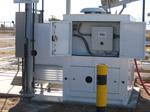
Case Study: Pulse Technology Breaks Up FOG Cap at Lift Station

The PHI-500-1 is a self-contained compressor system that helps mix fats, oils, and grease (FOG) back into wastewater.
The Problem:
A lift station serving the Arizona State Prison Complex-Tucson had a particular problem with fats, oils and grease (FOG). According to Cherie Randall, construction manager at the facility,
the grease problem is coming from kitchen grease traps that are not being properly pumped out. The complex has a population of 2,000 men, who are permitted to have family-supplied food during holidays and they sometimes heat canned goods using "stingers." Randall added that it was "not likely" that inmates discarded food down the toilet.
In any case, a large amount of FOG formed a grease cap in the 40-x-10-x-50-foot lift station that pumps wastewater from the complex to the Pima County Regional Wastewater Reclamation Department. Operators had to repeatedly clear the lift station.
FOG is a perpetual problem in some sewage lift stations and intermittent in others. It can foul lift station pumps, creating the potential for sewage backup and/or overflow. Traditionally, solutions include vacuum trucks, scrubbing, mechanical mixers, and chemical solutions, but these have their own drawbacks. Scrubbing a lift station can require fresh water, which is wasted in the process. Mechanical mixers are subject to breakdown and are often energy inefficient. Chemical solutions can be expensive and require extended periods of time before they are effective.
The Solution: The Tucson complex installed the PHI-500-1 from Pulsed Hydraulics Inc. The self-contained compressor system, which is housed in a heated and ventilated steel enclosure, was set on an 8-foot by 5-foot concrete pad. Connected to a power source, the compressor provides a burst of air through a hose that was inserted into the lift station with an 8-inch forming plate that helps mix the grease back into the wastewater.
A massive bubble rises from the forming plate. As the bubble ascends, it drafts material in the lift station with it. The pressure on the FOG cap causes the material to splinter and, after a relatively short time, liquefy. As the air dissipates at the top of the lift station, the energy then flows to the edge of the tank where it will begin its downward thrust. By pulsing the air bursts every 8 to 12 seconds, the continuous circulation prevents re-formation of the cap.
"The system is truly plug and play,” said Marten Madrid, maintenance supervisor, Arizona Department of Corrections. "Not only did the PHI-500-1 solution solve our grease problem, it also solved our odor problem,” he added.
A Kaesar 5-hp rotary screw compressor drives the system during the 2-hour-per-day activation period. This limited operation prohibits FOG formation and eliminates odor. It is also energy efficient.
The system ranges in cost from $10,000 to the top end of $29,000, which includes a full enclose and screw compressor design.